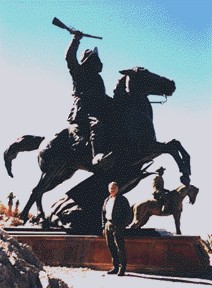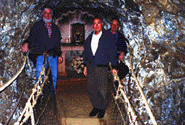Colonial Mexico
(Day 2 & 3) Zacatecas
 Zacatecas,
capital of the state of the same name, is built in a ravine on
the slopes of Cerro de la Bufa, a rock-crowned hill 8,748 feet
high. Long a mining center, the settlement was taken by the Spaniards
in 1548. In 1588, it was named ''The Very Noble and Loyal City
of Our Lady of the Zacatecas'' because of the vast quantities
of silver shipped from the region to Spain. Although now surrounded
by agricultural and cattle-raising lands, Zacatecas continues
to be a center for silver mining. The largest mine in the region
is 200-year-old El Bote, which is still in operation.
Zacatecas,
capital of the state of the same name, is built in a ravine on
the slopes of Cerro de la Bufa, a rock-crowned hill 8,748 feet
high. Long a mining center, the settlement was taken by the Spaniards
in 1548. In 1588, it was named ''The Very Noble and Loyal City
of Our Lady of the Zacatecas'' because of the vast quantities
of silver shipped from the region to Spain. Although now surrounded
by agricultural and cattle-raising lands, Zacatecas continues
to be a center for silver mining. The largest mine in the region
is 200-year-old El Bote, which is still in operation.
Elaborate old mansions, an aqueduct and stone steps connecting
steeply inclined flagstone streets lend the city a medieval atmosphere,
and also attest to the ostentatious wealth generated by the mines.
Within a 12-block area are several colonial buildings, including
the baroque Cathedral, Government Palace, Calderón Theater,
Church of San Agustín and Church of Santo Domingo.
We again rode directly
into the "El Centro" and found an excellent hotel just
one block off the Plaza. The Hotel Meson de la Merced is a slightly
upscale hotel with a parking garage and very friendly staff.
It is perfectly located in the heart of all the historical buildings
and plazas.
Cerro de la Bufa is the rock-topped hill which overlooks and
dominates Zacatecas
from the north-east. The most appealing of the many explanations
for its name is that
bufa is an old Spanish word for wineskin, which is certainly
what the rocky formation
atop the hill looks like. The views from the top are superb and
there's an interesting
group of monuments, a chapel and a museum up there. An exciting
and convenient way to ascend la Bufa is by the teleferico (cable
car) from near the El Eden mine exit.
 The Patrocinio Chapel, erected
in 1728 on the Cerro de la Bufa, offers an exceptional view of
the town and its mountain setting. The Battle of Zacatecas Museum
at the summit chronicles Pancho Villa's capture of the city in
the 1914 battle fought on the slopes of la Bufa in which the
revolutionary Divisi6n del Norte, led by Francisco 'Pancho' Villa
and Felipe Angeles, defeated the forces of President Victoriano
Huerta.
The Patrocinio Chapel, erected
in 1728 on the Cerro de la Bufa, offers an exceptional view of
the town and its mountain setting. The Battle of Zacatecas Museum
at the summit chronicles Pancho Villa's capture of the city in
the 1914 battle fought on the slopes of la Bufa in which the
revolutionary Divisi6n del Norte, led by Francisco 'Pancho' Villa
and Felipe Angeles, defeated the forces of President Victoriano
Huerta.
This gave the revolutionaries control of Zacatecas, which was
the gateway to Mexico City, in this War to depose the unpopular
Huerta. The museum is open Tuesday to
Sunday, 10 am to 4 pm.
 The
El Eden mine, once one of Mexico's richest mines, is a "must"
for visitors to Zacatecas because of the dramatic insight it
gives into the source of wealth in this region - and the terrible
price paid for it. Digging for fabulous hoards of silver, gold,
iron, copper and zinc, enslaved Indians, including many children
worked under horrific conditions. At one time up to five a day
died from accidents or illness. El Eden was worked from 1586
until the 1950s. Today, the fourth of its seven levels is kept
open for visitors. We spent about two hours exploring the old
mine shafts, observing the many levels still open for viewing
and, using our basic Spanish, learned from the guide the long
history of this once fantastically wealthy mine. Much of the
gold and silver going to Spain during the early Colonial days
came from this mine. It is estimated that over 40,000 Indians
died during the mines early slave period! The photo graph pictured
here is taken in front of the third level chapel.
The
El Eden mine, once one of Mexico's richest mines, is a "must"
for visitors to Zacatecas because of the dramatic insight it
gives into the source of wealth in this region - and the terrible
price paid for it. Digging for fabulous hoards of silver, gold,
iron, copper and zinc, enslaved Indians, including many children
worked under horrific conditions. At one time up to five a day
died from accidents or illness. El Eden was worked from 1586
until the 1950s. Today, the fourth of its seven levels is kept
open for visitors. We spent about two hours exploring the old
mine shafts, observing the many levels still open for viewing
and, using our basic Spanish, learned from the guide the long
history of this once fantastically wealthy mine. Much of the
gold and silver going to Spain during the early Colonial days
came from this mine. It is estimated that over 40,000 Indians
died during the mines early slave period! The photo graph pictured
here is taken in front of the third level chapel.
 One of this author's favorite
restaurants in Mexico is located in Zacatecas. The open grill
and regional dishes are always superb. They serve a regional
red wine that complements their fine menu. I highly recommend
you try the restaurant "La Cantera Musical" - located
in the "Centro Historico." It is a short walk from
any hotel in the historic district.
One of this author's favorite
restaurants in Mexico is located in Zacatecas. The open grill
and regional dishes are always superb. They serve a regional
red wine that complements their fine menu. I highly recommend
you try the restaurant "La Cantera Musical" - located
in the "Centro Historico." It is a short walk from
any hotel in the historic district.
We spent two nights in Zacatecas in order to see all the sights and visit the many points of historical interest.
Next, on to one of the most colorful and romantic cities in Mexico. The Colonial gem of a city, Guanajuato.